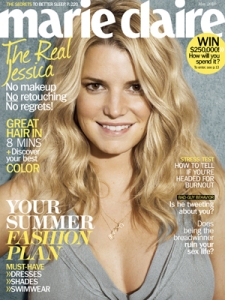Magazines, the Power of Print | MPA
May 17, 2010
I’m topping off a beautiful Vancouver weekend by curling up with some June 2010 issues of my favourite magazines. I’ve said it countless times, there is nothing like the ritual of sitting down with a magazine- true “me time”- and reading cover to cover.
But, I had hardly gotten far before I came across an ad that I had to rip out, press on to a hard cardboard backing, and put aside for framing purposes. Hello Magazine Publishers of America, you’ve gotten my attention:
This is the video version, from the MPA site, of the ad that so caught my attention. The video is great, but the print ad really was almost better. It epitomized why we read magazines: to learn about interesting and exciting things in a way that is aesthetically intelligent and pleasing, furthering the overall point and creating an experience.
With so much hope in publishing, there is hope for publishing. Not that I was ever worried about magazines.
Marie Claire | Generation Burnout [May 2010]
April 20, 2010
Marie Claire has a monthly column called “The Careerist” which is one of my favourite sections. This month’s issue is an article called “Generation Burnout,” and with a focus on recent Project Runway drop-out Maya Luz, it investigates the working trends of women my age.
Competitors of Project Runway are not allowed a moment off camera while simultaneously being set up with nearly impossible challenges and barely getting any rest. Of course, it is the show’s 24/7 nature that pumps out pros. Think of it like a road test: it’s not like you really have to drive that perfectly all the time, but the examiner just needs to know that you can. Luz, a 22 year old design school graduate, was a top prospect on the popular show, but ultimately found the conditions so stressful that she left the competition early. Who can blame her? The conditions really do seem enough to drive anyone mad.
But surely, this is just a show. And this girl, while maybe not cut out to play up her insecurities, talents, emotions and work ethic on television for a world-wide audience, will likely have better success off the show. Which leads us to the biggest question this article poses:
What if these conditions are simply becoming standard for young people breaking into the work force (outside of reality TV) today?
We’ve all heard the argument against this which goes that we Generation Y’ers are entitled little brats who don’t know the meaning of a dollar, of time, of sacrifice or commitment. Certainly our pop culture is a little disheartening, and our escapist television shows do paint us in that light. But, please, every generation has hard working people and every generation has slackers.
Luckily “Generation Burnout” does not accuse anyone of being the latter. But it does point out both perspectives.
Perhaps Generation Y-ers are too quick to walk away from a challenge. Maybe we, en masse, do believe that we deserve a little bit more than we do.
But I hear about the entitlement of this generation so much it’s exhausting. It begins to be temping to look at the way the older generation had it made. From down here it often looks like Generation X could get away with only a high school degree- if that- jump right into the workforce successfully, and begin owning their own Vancouver home before turning 30.
The truth has to lie somewhere in between, but I did pick up some scary tidbits of information from this article too. More than a few younger people talked about the terrible conditions of the internships they undertook. Internships are truly a controversial topic, and I will talk further upon this in another post.
The experiences of these people were not my own (at all), but I have heard similar horror stories from friends: full time hours with no pay, thankless menial tasks, combined with the pressure to put this at the forefront of your life. At its ideal, an internship should be a symbiotic experience, but this was certainly not what was being described.
Though I believe whole-heartedly in living a balanced life, I am first and foremost ambitious. The idea of being really busy doesn’t bother me. My week consists of running out the door to my full-time job, two internships, a volunteer position with an alumnae association, and fitting in a work out. I like to believe that this kind of running around, learning, and growing is ultimately leading somewhere. If this is paying my dues, I’m writing the cheque.
But everyone deserves to be able to pencil in some me-time to their schedule. We can’t live a lifestyle that renders us devoid of relationships, experiences and joy. This kind of bending over backwards cannot be what is expected as a bare minimum these days. Likewise, the expectations of generation Y’ers cannot be to have millions in the bank AND loads of free time by 25 years-old.
Unfortunately, I, like the article itself, don’t really have an answer to any of these questions. But I do consider a more open dialogue between those in the workforce and those hoping to break in a very positive step towards a- oh! fancy that- more symbiotic working experience.
